The Majestic Sebright Chicken
You’ve probably heard of chickens before, but have you ever heard of the majestic Sebright chicken?
With its stunning golden or blue feathers, the Sebright chicken is truly a sight to behold.
These exquisite birds are known for their small size and distinctive plumage, making them a favorite among poultry enthusiasts.
Whether you’re an experienced chicken keeper or simply intrigued by these fascinating creatures, the Sebright chicken is sure to capture your attention and leave you wanting to learn more.
The Majestic Sebright Chicken
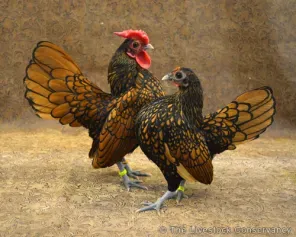
This image is property of livestockconservancy.org.
Overview of the Sebright Chicken
The Sebright Chicken is a small and beautiful breed of chicken known for its striking appearance and distinctive features.
In this article, we will delve into the fascinating world of Sebright Chickens, exploring their history, characteristics, breeding, care, and much more.
History of the Sebright Chicken
The Sebright Chicken has a rich history that dates back to the early 19th century. It was named after its creator, Sir John Sebright, who was a prominent English gentleman and poultry breeder.
Sir John Sebright dedicated many years of his life to perfecting this breed, focusing on attributes like feather quality and lacing patterns.
Today, the Sebright Chicken stands as a testament to his dedication and passion for poultry.
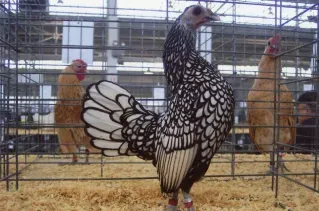
This image is property of i.redd.it.
Origins and Breed Development
The Sebright Chicken is believed to have been developed from a combination of different breeds, including the Polish chicken, Nankin bantam, and possibly the Indian Game fowl.
Through careful and selective breeding, Sir John Sebright aimed to create a breed that was aesthetically pleasing and displayed unique lacing patterns throughout its feathers. His efforts resulted in the creation of the Sebright Chicken as we know it today.
Purpose and Popularity
Unlike many other chicken breeds, the Sebright Chicken was not developed for its utility or egg-laying abilities. Instead, it was primarily bred for its ornamental qualities, making it a popular choice for poultry exhibitions and shows.
The Sebright Chicken’s striking appearance and delicate size captivate the hearts of chicken enthusiasts worldwide.
However, despite its growing popularity, the breed remains relatively rare and is often sought after by dedicated breeders and collectors.
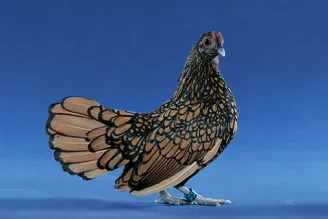
This image is property of cdn.shopify.com.
Interesting Facts about Sebright Chickens
Smallest Breed of True Bantams
Sebright Chickens are unique in their classification as the smallest true bantam breed. Unlike other bantam breeds, which have large fowl counterparts, Sebright Chickens are exclusively bred in their miniature form, with no standard-sized version available.
This compact size adds to their charm and allure, making them highly sought after by those looking for petite and adorable chickens.
Silver and Gold Varieties
Sebright Chickens come in two distinctive varieties: silver and gold. The silver variety features a striking white plumage with black lacing, while the gold variety displays a stunning combination of rich, golden feathers and black lacing.
Both varieties are equally captivating and contribute to the breed’s overall charm and beauty.
Prized for Their Unique Lacing
One of the most outstanding features of the Sebright Chicken is its intricate lacing pattern.
The feathers of these chickens are delicately edged with thin black lines, creating a stunning contrast against the silver or gold background. Each feather seems to be meticulously painted with precision, highlighting the breed’s exquisite attention to detail.
Exceptional Feather Quality
In addition to their beautiful lacing, Sebright Chickens are known for their exceptional feather quality. Their feathers are notably close-fitting and lustrous, giving them an elegant and refined appearance.
This trait is a result of years of selective breeding, with breeders aiming to achieve the perfect combination of beauty and functionality in the breed’s plumage.
Appearance and Characteristics
Size and Weight
Sebright Chickens are petite in size, with cocks weighing around 22-26 ounces (625-737 grams) and hens weighing approximately 20-24 ounces (567-680 grams). Their small stature adds to their appeal, making them an ideal choice for those with limited space or urban chicken keeping.
Distinctive Features
The Sebright Chicken boasts several distinctive features that set it apart from other breeds. Its compact body is complemented by a proud, upright carriage and a distinctive rose comb.
See also Why People Love Their Silkie Chickens (And You Will Too
The breed also possesses strong and muscular thighs, giving it an agile and active appearance. Additionally, Sebright Chickens have well-spread tails, contributing to their overall balance and elegance.
Plumage and Colors
The plumage of Sebright Chickens is truly mesmerizing. In both the silver and gold varieties, the intricate lacing is the defining characteristic.
The feathers have a white or golden base color, with each individual feather edged in black, forming a unique lace pattern. This extravagant plumage is the result of careful breeding and genetic selection, creating a truly eye-catching bird.
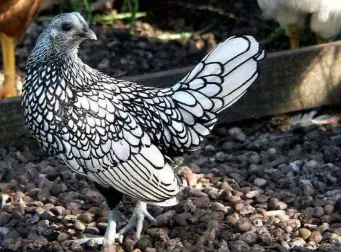
This image is property of historydaily.org.
Breeding and Genetics
Selective Breeding
Breeding Sebright Chickens requires a deep understanding of their genetic makeup and the desired traits that breeders aim to achieve. It involves selecting birds with the desired lacing pattern, feather quality, and overall conformation and breeding them selectively to maintain and improve these traits in subsequent generations.
Due to the breed’s unique characteristics, successful breeding requires patience, knowledge, and meticulous record-keeping.
Challenges in Breeding Sebright Chickens
Breeding Sebright Chickens can present a set of challenges, mainly due to the breed’s small size and delicate nature. It can be challenging to find birds that meet the breed standard and possess the desired traits, making it crucial to establish a network of reputable breeders.
Additionally, breeders must be mindful of certain genetic factors, such as maintaining proper comb type and preventing unwanted traits or color variations from emerging within the flock.
Understanding the Lacing Gene
The lacing pattern that is characteristic of the Sebright Chicken is the result of a complex genetic inheritance. It is controlled by a gene known as “Lacing Gene.” This gene interacts with other genes to produce the intricate, well-defined lacing visible in the feathers.
Understanding the intricacies of the lacing gene is crucial for breeders to achieve consistent and desirable lacing patterns in their breeding programs.
Raising Sebright Chickens
Suitable Environments
Sebright Chickens can be successfully raised in a variety of environments, including urban settings, provided they have adequate housing and protection from predators.
Their small size and agility make them well-suited for confinement, but they can also thrive in free-range environments with proper supervision.
Ideal Climate Conditions
Sebright Chickens are hardy birds and can adapt to a wide range of climates. However, they are more suited to temperate or mild environments rather than extreme heat or cold. Providing appropriate shelter and ventilation in extreme climates will help ensure their comfort and well-being.
Temperament and Behavior
Sebright Chickens are known for their friendly and docile nature, making them delightful companions in any flock. They are relatively calm and gentle, making them suitable for families with children.
However, due to their small size, they may be more susceptible to bullying from larger, more aggressive breeds.
Compatibility with Other Breeds
Sebright Chickens generally get along well with other breeds, particularly those of similar size and temperament. While they may be able to hold their ground against larger fowl, it is essential to monitor their interactions and provide enough space and resources to prevent any conflicts.
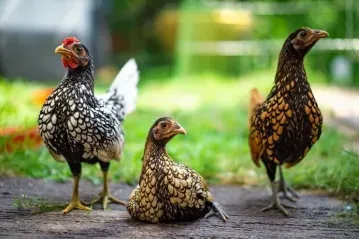
This image is property of www.chickensandmore.com.
Housing and Coop Requirements
Coop Size and Design
Due to their small size, Sebright Chickens require less space compared to larger breeds. The recommended minimum coop size for a pair of Sebright Chickens is four square feet (0.37 square meters).
However, providing them with additional space for exercise and enrichment is always beneficial. Ensuring proper ventilation and insulation in the coop is crucial for their overall well-being.
Nesting Boxes and Roosts
Sebright Chickens require a comfortable and secure nesting area to lay their eggs.
A cozy nesting box with soft bedding material, such as straw or wood shavings, will encourage them to lay eggs regularly. Additionally, providing suitable roosting perches at varying heights will allow them to exercise their natural roosting instincts.
Predator Protection
Despite their small size, Sebright Chickens are not exempt from predation. Ensuring their safety requires implementing predator-proofing measures such as sturdy fencing, secure coop doors, and wire mesh or hardware cloth to prevent entry by potential predators. Regular inspections and maintenance of coop security will help keep predators at bay.
See also Why Your Chickens Might Be Laying Green Eggs (And What You Can Do About It)
Ventilation and Light
Proper ventilation is essential for maintaining good air quality in the coop.
Adequate airflow will help prevent the buildup of moisture and ammonia, which can lead to respiratory issues in chickens. Additionally, providing natural light or suitable artificial lighting in the coop will help regulate their circadian rhythms, promoting healthy sleep patterns and overall well-being.
Feeding and Nutrition
Balanced Diet for Sebright Chickens
Sebright Chickens, like all chickens, require a balanced diet to thrive.
Their diet should consist of a high-quality layer feed specifically formulated for bantam breeds. This feed provides them with essential nutrients, including protein, vitamins, and minerals necessary for optimal growth and egg production.
Offering a mixture of grains, seeds, and fresh fruits and vegetables as treats can supplement their diet and provide added variety.
Appropriate Feed Types
When selecting a feed for Sebright Chickens, it is essential to choose a feed specifically formulated for bantam breeds or small-sized chickens.
These feeds typically have smaller-sized pellets or crumbles, making it easier for the Sebrights to consume. Avoid feeding them medicated feeds unless specifically recommended by a veterinarian.
Supplementing with Treats
Sebright Chickens enjoy a variety of treats, but it is crucial to feed them in moderation to avoid nutritional imbalances.
Treats should be offered as a supplement to their main diet and consist of nutritious options like mealworms, fresh fruits, vegetables, and scratch grains. Remember to introduce new treats gradually, as sudden dietary changes can upset their digestive system.
Watering Requirements
Fresh, clean water should be available to Sebright Chickens at all times. Ensure that their water source is kept clean and free from debris. During extreme weather conditions, it is vital to regularly check their water containers to prevent freezing in cold temperatures or overheating in hot weather.
Health and Care
Common Health Issues
Sebright Chickens, like any breed, may be susceptible to certain health issues. Some common health concerns include respiratory infections, external parasites like mites and lice, and reproductive disorders.
Regular health checks, vaccinations where appropriate, and diligent observation can help detect and address any health issues promptly.
Routine Health Checks
Performing routine health checks on your Sebright Chickens is crucial to ensure their well-being. This includes monitoring their appetite, behavior, and overall appearance.
Regularly inspect
ing their plumage for signs of parasites, checking their comb and wattles for signs of infection or frostbite, and observing their droppings for any abnormalities can help in identifying health issues early on.
Vaccination and Disease Prevention
Consulting with a poultry veterinarian is highly recommended to determine the appropriate vaccination schedule for your Sebright Chickens.
Vaccinations can help protect them against common poultry diseases such as Marek’s disease and Newcastle disease.
Also, implementing good biosecurity measures, such as regular cleaning and disinfection of the coop, preventing contact with wild birds, and quarantining new birds, can help prevent the introduction and spread of diseases.
Maintaining Good Hygiene
Maintaining good hygiene practices is essential for the overall health and well-being of Sebright Chickens. Regularly cleaning and disinfecting the coop, removing soiled bedding, and providing fresh bedding material promote a clean and healthy environment.
Additionally, practicing good personal hygiene, such as washing hands before and after handling chickens, can help prevent the spread of potential pathogens.
Common Issues and Problems
While Sebright Chickens are generally hardy birds, they may encounter some challenges unique to their breed. Common issues include difficulties in breeding, potential genetic abnormalities, and vulnerability to bullying from larger breeds.
Addressing these issues requires careful consideration and consultation with experienced breeders or avian specialists to ensure the health and viability of the breed.
Conclusion
The Sebright Chicken is a remarkable breed that captivates the hearts of chicken enthusiasts with its elegance, beauty, and charming personality.
Whether you are drawn to their distinctive lacing patterns, exquisite feather quality, or their petite size, Sebright Chickens are sure to add a touch of majesty to any flock.
While they may present some challenges in breeding and care, the rewards of owning and appreciating these majestic birds are well worth the effort.
So, if you’re seeking a unique and enchanting addition to your flock, look no further than the awe-inspiring Sebright Chicken.
